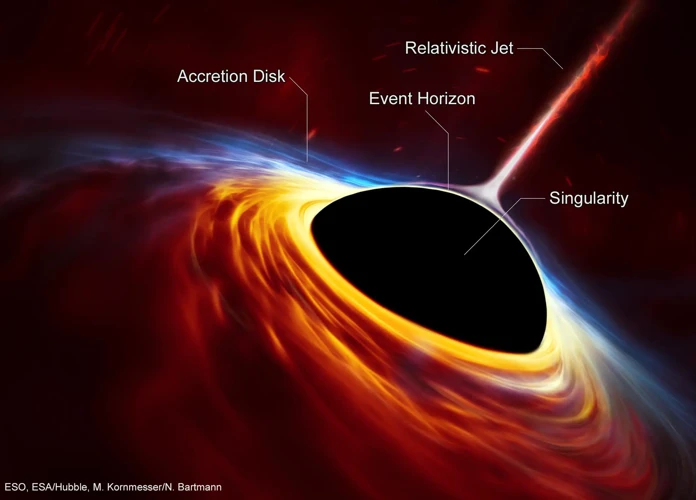It is a realm of infinite curiosity and unfathomable mystery, where the laws of physics crumble under the immense force of gravity. We find ourselves venturing into the unknown, exploring the boundary that separates the known from the unknowable – the Event Horizon. This ethereal boundary encompasses black holes, the enigmatic celestial objects that have captivated astronomers and physicists for centuries. In this article, we will embark on a journey to understand the Event Horizon, its formation, characteristics, and the profound implications it holds for our understanding of the universe. Join us as we delve deep into the enigma that is the Event Horizon and strive to unlock its secrets.
Contents
- What is the Event Horizon?
- Formation of the Event Horizon
- Characteristics of the Event Horizon
- Studying the Event Horizon
- Theoretical Implications
- The Event Horizon Telescope
- Conclusion
-
Frequently Asked Questions
- 1. What happens if an object crosses the Event Horizon of a black hole?
- 2. Can anything escape from the Event Horizon?
- 3. How is the size of an Event Horizon determined?
- 4. Are all black holes surrounded by an Event Horizon?
- 5. Can we directly observe the Event Horizon of a black hole?
- 6. What happens to time near the Event Horizon?
- 7. Is the Event Horizon a physical barrier?
- 8. Can a black hole’s Event Horizon ever shrink or expand?
- 9. Is the Event Horizon the same for all types of black holes?
- 10. Are there any proposed alternative theories to the existence of the Event Horizon?
- References
-
Frequently Asked Questions
- 1. How is the event horizon defined?
- 2. Can anything pass through the event horizon?
- 3. How is the event horizon formed?
- 4. What is the significance of the Schwarzschild radius?
- 5. What happens at the event horizon?
- 6. Can we observe the event horizon directly?
- 7. What happens when matter crosses the event horizon?
- 8. Can black holes emit any form of energy?
- 9. How could the event horizon help solve the quantum information paradox?
- 10. Why is the discovery of the event horizon important?
- References
- Read More
What is the Event Horizon?
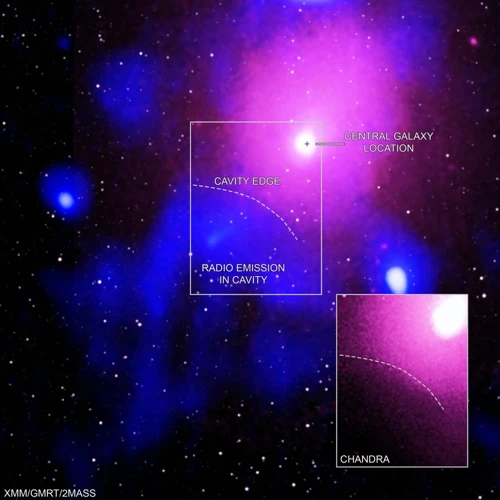
The Event Horizon is a term used in astrophysics to describe the boundary around a black hole where the gravitational pull becomes so immense that nothing, not even light, can escape its grasp. It is the point of no return, where the laws of physics as we know them cease to exist. The Event Horizon marks the border between the observable universe and the infinite density at the center of a black hole, known as the singularity. At this boundary, the escape velocity surpasses the speed of light, trapping anything that crosses it within the black hole’s gravitational grip. This phenomenon is a result of the immense mass and compactness of a black hole, which warps the fabric of spacetime itself. It is important to note that the Event Horizon is purely theoretical, as the extreme forces and conditions near a black hole make direct observation impossible. Nevertheless, its existence and properties have been deduced through mathematical equations and observations of the effects black holes have on their surroundings.
Formation of the Event Horizon
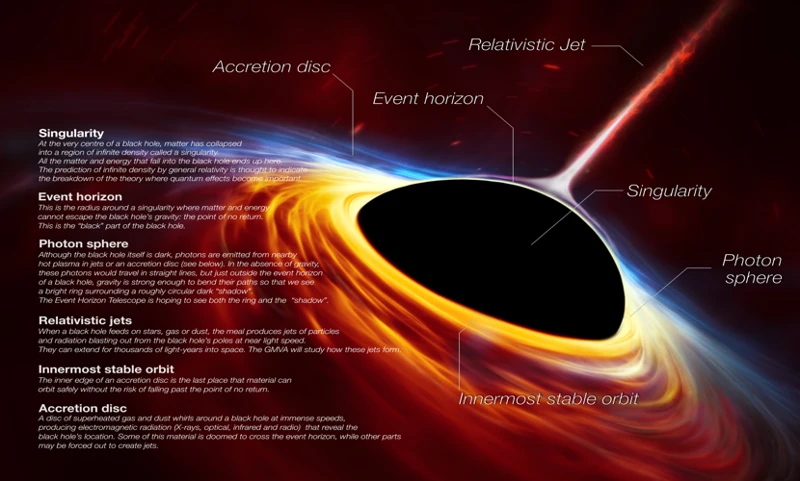
Formation of the Event Horizon occurs through a process known as gravitational collapse, which happens when a massive star reaches the end of its life cycle. The core of the star, after exhausting its nuclear fuel, can no longer sustain the outward pressure generated by nuclear fusion. As a result, the core collapses under its own gravity, causing an immense increase in density and temperature. This collapse gives rise to a black hole, with the Event Horizon marking the boundary beyond which escape is impossible. The size of the Event Horizon, known as the Schwarzschild radius, depends on the mass of the black hole. The greater the mass, the larger the Schwarzschild radius, and consequently, the larger the Event Horizon. This means that more massive black holes have larger boundaries from which not even light can escape. According to Einstein’s theory of general relativity, the formation of an Event Horizon leads to the creation of a singularity, a point of infinite density where the laws of physics break down. The singularity is hidden within the black hole, forever concealed by the Event Horizon’s captivating grasp. Understanding the formation of the Event Horizon provides insight into the nature of black holes and the intricate interplay between gravity and matter in the vast expanse of the universe.
1. Gravitational Collapse
Gravitational collapse is the phenomenon that leads to the formation of a black hole’s Event Horizon. It occurs when a massive star exhausts its nuclear fuel and can no longer sustain the outward pressure generated by the fusion reactions in its core. Without this pressure, the star succumbs to the relentless force of gravity. The inward pull becomes overpowering, causing the star to collapse in on itself. The collapse is incredibly swift, and the star’s core becomes increasingly dense. As the core collapses, the gravitational forces become stronger, compressing matter to an extraordinary degree. Eventually, the core reaches a critical point known as the Schwarzschild radius, named after the German physicist Karl Schwarzschild. This radius represents the point at which the core’s density becomes so immense that it forms a singularity, a region of infinite curvature and gravity at the center of the black hole. The singularity is hidden within the Event Horizon, beyond the reach of observation. The process of gravitational collapse is a mesmerizing and terrifying force of nature, shaping the existence of black holes as we understand them.
2. Schwartzschild Radius
The Schwartzschild Radius, named after the German physicist Karl Schwarzschild, is a fundamental concept that helps define the boundary of the Event Horizon. It represents the distance from the center of a black hole to its Event Horizon, at which point the escape velocity equals the speed of light. The Schwartzschild Radius is directly proportional to the mass of the black hole, meaning that the more massive the black hole, the larger its radius will be. Mathematically, the Schwartzschild Radius is calculated using the formula Rs = 2GM/c^2, where G is the gravitational constant, M is the mass of the black hole, and c is the speed of light. This formula shows that as the mass of the black hole increases, the Schwartzschild Radius also increases, indicating a larger Event Horizon. Understanding the Schwartzschild Radius is crucial in comprehending the significance and properties of the Event Horizon and the extreme gravitational forces that exist within the vicinity of a black hole. Exploring this concept leads us deeper into the mysteries of the universe and the profound impact black holes have on the fabric of space and time.
Characteristics of the Event Horizon

The Event Horizon possesses several distinctive characteristics that set it apart from any other region in the universe.
1. Point of No Return: Once an object crosses the Event Horizon, it is forever trapped within the gravitational grip of the black hole. The immense gravitational force prevents anything, including light, from escaping. Objects that venture too close to the Event Horizon will inevitably be consumed by the black hole, with their energy and matter becoming part of its mass.
2. Energy and Matter Capture: As matter falls into a black hole’s gravitational well and approaches the Event Horizon, it undergoes extreme compression and heating due to the intense gravitational forces. This phenomenon produces intense radiation and emission of high-energy particles, often observed as bright accretion disks around black holes. Quasars, for example, are immensely bright astronomical objects believed to be powered by matter falling into a supermassive black hole.
3. Distortion of Spacetime: The immense mass of a black hole warps the fabric of spacetime, causing it to curve in its vicinity. The Event Horizon marks the point at which the distortion becomes so severe that even light cannot escape. The gravitational time dilation near the Event Horizon creates a significant time difference between an observer near the black hole and one much further away, an effect known as gravitational time dilation.
These characteristics of the Event Horizon provide crucial insights into the behavior and properties of black holes, offering a glimpse into the mysterious and intricate nature of these cosmic entities.
1. Point of No Return
The Point of No Return is a defining characteristic of the Event Horizon. Once an object crosses this boundary, it is forever trapped within the gravitational pull of the black hole. At this point, the escape velocity required to break free from the black hole’s gravity exceeds the speed of light, rendering escape impossible. The extreme curvature of spacetime near the Event Horizon causes all paths to lead inward, preventing anything from escaping, including light itself. This creates a region of darkness, known as the black hole’s shadow, where no information or radiation can be detected from the outside world. The Point of No Return marks the boundary where the forces of gravity become overwhelming, forever sealing the fate of anything that ventures too close. In the realm beyond the Event Horizon, the laws of physics as we understand them break down, giving rise to a realm of unimaginable density and singularity. It is a realm where time slows down and distances become infinitely distorted, defying our current understanding of the universe. This concept of an inescapable threshold, where the very fabric of reality is altered, opens up deep philosophical and scientific questions about the nature of existence and the limits of our knowledge. Ultimately, the Point of No Return is a captivating and mysterious aspect of the Event Horizon that continues to fascinate and perplex scientists and philosophers alike.
2. Energy and Matter Capture
Energy and matter capture are two fundamental aspects of the Event Horizon’s behavior. As objects approach the Event Horizon of a black hole, the intense gravitational pull causes them to accelerate to tremendous speeds. This acceleration results in a release of vast amounts of energy, often in the form of X-rays and gamma rays. Some of the captured matter, such as gas and dust, spirals around the black hole in a process called accretion. This matter forms a disk-like structure known as an accretion disk. The extreme conditions near the Event Horizon cause the material in the accretion disk to heat up and emit powerful radiation. As the matter gets closer to the Event Horizon, it eventually crosses the boundary and gets consumed by the black hole, adding to its already immense mass. This process of energy and matter capture plays a crucial role in the growth and evolution of black holes. It also has significant implications for understanding the behavior of surrounding celestial objects, such as binary star systems, where one star can be stripped of mass by its companion and be captured by a black hole, leading to powerful bursts of energy and radiation. The study of energy and matter capture by black holes is an active area of research in astrophysics, shedding light on the complex dynamics of these enigmatic cosmic entities.
3. Distortion of Spacetime
The distortion of spacetime is a fundamental characteristic of the Event Horizon surrounding a black hole. As an object approaches the Event Horizon, the gravitational pull becomes stronger, causing spacetime to warp and bend in its vicinity. This distortion is a consequence of the immense mass of the black hole, which curves the fabric of spacetime itself. This warping effect results in a phenomenon known as time dilation, where time appears to slow down for an observer near the Event Horizon compared to a distant observer. The closer an object gets to the Event Horizon, the more severe the distortion becomes, creating a gravitational gradient that stretches and compresses spacetime. This distortion is analogous to a heavy object placed on a stretched rubber sheet, causing neighboring objects to roll towards it. Similarly, objects near the Event Horizon are pulled towards the black hole due to the curvature of spacetime. This profound distortion of the fabric of the universe is a testament to the immense power and gravitational force exerted by black holes.
In addition to distorting spacetime, the gravitational pull near the Event Horizon also causes gravitational lensing. This phenomenon occurs when light from distant objects passes near a black hole and is bent by its gravitational field. As a result, the trajectory of the light is altered, making distant objects appear distorted or magnified to an observer near the black hole. This effect has been observed and confirmed by scientists through the study of gravitational lensing events in which light from background galaxies is bent and magnified by the gravitational field of a black hole. The gravitational lensing caused by the Event Horizon provides valuable insights into the astrophysical properties of black holes and the nature of spacetime itself.
The distortion of spacetime near the Event Horizon is a fascinating aspect of black holes that highlights the extreme conditions and bizarre physics taking place within their vicinity. It is a reminder of the mind-boggling power and gravitational pull that these cosmic entities possess, and it continues to intrigue and challenge our understanding of the universe.
Studying the Event Horizon
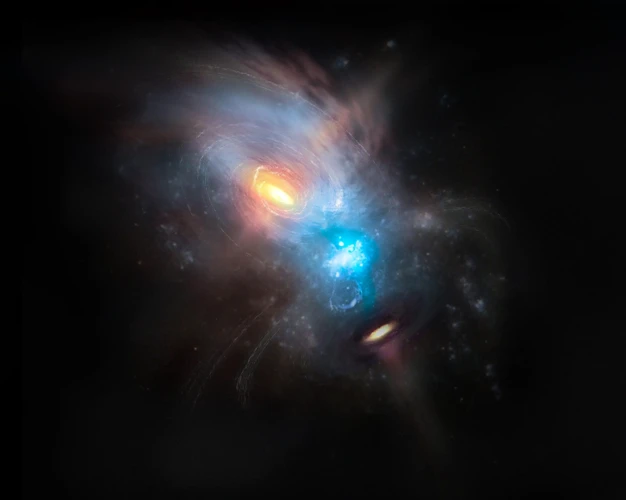
Studying the Event Horizon is a challenging yet crucial endeavor in our quest to unravel the mysteries of black holes. While we cannot directly observe the Event Horizon itself, scientists employ various methods and technologies to understand its characteristics and implications. One approach is the establishment of dedicated Black Hole Observatories, such as the Event Horizon Telescope (EHT) collaboration. These observatories utilize a network of interconnected telescopes spanning the globe, creating a virtual telescope with a resolution equivalent to the size of the Earth. By synchronizing observations, scientists can capture and analyze radio waves emitted from the vicinity of black holes, providing valuable insights into the behavior of the Event Horizon. Another avenue of study is investigating the effect of black holes on their surrounding environment. As black holes consume and accrete matter, they generate powerful jets and X-ray emissions that can be detected and analyzed. These emissions provide valuable clues about the dynamics of the Event Horizon and its impact on the surrounding space. Through these observational techniques and diligent analysis, scientists continue to expand our understanding of the elusive Event Horizon and push the boundaries of our knowledge about black holes and the nature of the universe.
1. Black Hole Observatories
Black hole observatories play a crucial role in our quest to understand the mysteries of the Event Horizon. These observatories are equipped with powerful telescopes and advanced instruments designed to observe the effects of black holes on their surroundings. One such observatory is the Event Horizon Telescope (EHT), a network of radio telescopes spread across the globe. The EHT is able to capture high-resolution images of black holes by utilizing a process called interferometry, where multiple telescopes work together to create a virtual telescope with the resolving power of a telescope the size of the Earth. By studying the behavior of matter and light around black holes, these observatories provide valuable insights into the properties of the Event Horizon. They have helped confirm the existence of event horizons and allowed scientists to study the gravitational effects of black holes on stars, gas, and other celestial objects. Through these observations, scientists continue to push the boundaries of our understanding of the Event Horizon and delve deeper into the nature of black holes.
2. Effect on Surrounding Environment
The Effect on Surrounding Environment caused by the presence of a black hole and its Event Horizon is both fascinating and profound. As a black hole devours nearby matter and energy, it has a significant impact on its surroundings. The intense gravitational pull of a black hole can cause nearby objects, such as stars or other celestial bodies, to be disrupted or even torn apart. This process, known as tidal disruption, results in the formation of an accretion disk, a swirling disk of matter that spirals towards the black hole’s Event Horizon. The immense heat and friction within the accretion disk generate enormous amounts of energy, emitting powerful X-rays and gamma rays that can be detected by telescopes. These energetic emissions provide valuable information about the black hole’s properties and the dynamics of its surrounding environment. Additionally, the gravitational influence of a black hole can have a profound effect on the motion of nearby objects, distorting their orbits and altering the flow of gas and dust in the vicinity. Studying these effects allows scientists to gain insights into the nature of black holes and their role in shaping the evolution of galaxies and the universe at large. Understanding the Influence of a black hole’s Surrounding Environment is crucial in unraveling the complex interactions between these cosmic powerhouses and the cosmic web they inhabit.
Theoretical Implications
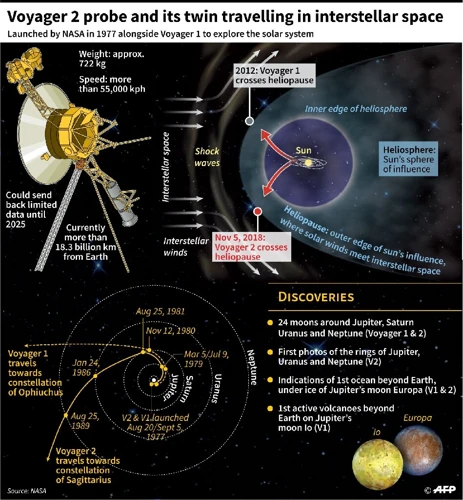
Theoretical implications surrounding the Event Horizon are vast and have profound implications for our understanding of the universe. One such implication is the Quantum Information Paradox, which relates to the fate of information that enters a black hole. According to quantum mechanics, information is never truly lost but is instead preserved in an encoded form. However, the presence of a black hole challenges this principle, as anything that crosses the Event Horizon seemingly disappears from the observable universe. This paradox has sparked intense debate among physicists and has led to the development of theories such as black hole evaporation through Hawking radiation. Another theoretical implication is the emission of gravitational waves. As two black holes merge, the resulting gravitational waves ripple through spacetime, creating detectable disturbances. The observation of gravitational waves has provided further evidence for the existence of black holes and has opened up a new avenue of research in the field of astrophysics. The study of these theoretical implications not only deepens our understanding of black holes but also sheds light on the fundamental nature of space, time, and information in the universe.
1. Quantum Information Paradox
The Quantum Information Paradox revolves around the fundamental principles of quantum mechanics and their implications for black holes. According to quantum mechanics, information cannot be destroyed; it can only be transformed or encoded in a different form. However, black holes pose a challenge to this principle. When an object falls into a black hole and crosses the Event Horizon, it is believed to be irretrievably lost from the perspective of an outside observer. This raises a paradox known as the “information loss paradox,” which questions the conservation of information in the universe. If information is indeed lost within a black hole, it would violate the principles of quantum mechanics. Several theories and hypotheses have been proposed to reconcile this paradox, such as the idea that information is somehow encoded in the Hawking radiation emitted by black holes. This ongoing puzzle continues to intrigue physicists and drive further research into the nature of black holes and the workings of the quantum world. Understanding the resolution of this paradox is crucial for unraveling the deep interplay between gravity, quantum mechanics, and the fabric of the universe itself.
2. Gravitational Wave Emission
Gravitational Wave Emission is an intriguing aspect of the Event Horizon that has garnered significant attention in the realm of astrophysics. As objects spiral towards a black hole and cross the Event Horizon, they release immense amounts of energy in the form of gravitational waves. These ripples in the fabric of spacetime propagate outward, carrying information about the dynamics and characteristics of the black hole itself. Gravitational wave detectors, such as the Laser Interferometer Gravitational-Wave Observatory (LIGO), have been instrumental in detecting and studying these elusive waves. The detection of gravitational waves from merging black holes has provided groundbreaking evidence for the existence of black holes and has opened up new avenues for research and exploration in the field of astrophysics. By analyzing the properties of gravitational wave emissions, scientists can glean valuable insights into the nature of black holes, their mass, spin, and even the precise geometry of their Event Horizons. The study of gravitational wave emission has thus revolutionized our understanding of black holes and has paved the way for further discoveries in the realms of cosmology and fundamental physics.
The Event Horizon Telescope
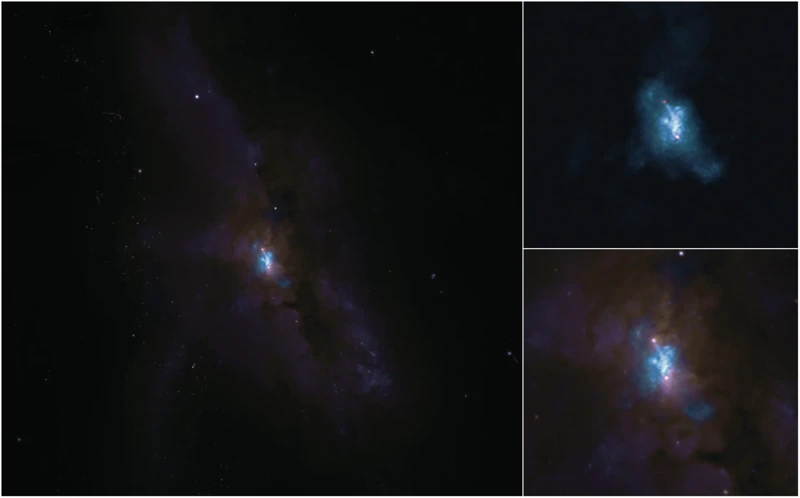
The Event Horizon Telescope (EHT) is an international collaboration of radio telescopes that work in unison to observe and capture high-resolution images of the immediate surroundings of black holes. This ambitious project brings together observatories located across the globe, creating a virtual telescope with an unprecedented level of detail and sensitivity. By combining the data from multiple telescopes using a technique called Very Long Baseline Interferometry (VLBI), the EHT can effectively create a telescope with a diameter of the Earth. This massive virtual telescope is capable of resolving details as small as the event horizon of a black hole. The EHT utilizes a technique known as radio interferometry, where multiple radio antennas are synchronized to create an interferometer that can accurately measure the incoming radio waves from black holes. By precisely timing the arrival of these waves at each location, astronomers can construct an image using intricate computational algorithms. The EHT has made significant contributions to our understanding of black holes, culminating in the groundbreaking achievement of capturing the first-ever direct image of a black hole’s event horizon in 2019. This momentous feat provided visual confirmation of the existence of black holes and brought us closer to unraveling the mysteries of these cosmic behemoths. The EHT’s collaborative efforts and cutting-edge technology have revolutionized our ability to study black holes and continue to push the boundaries of our understanding of the universe.
1. Collaborative Efforts
Collaborative efforts play a crucial role in the study of the Event Horizon, particularly when it comes to capturing and analyzing data from black holes. The Event Horizon Telescope (EHT) project is a prime example of such collaboration. It is an international endeavor involving astronomers and scientists from around the globe, working together to create a network of observatories and telescopes. By synchronizing and combining the observations from these diverse instruments, the EHT aims to create a virtual Earth-sized telescope capable of capturing images with unprecedented resolution. This collaborative approach allows researchers to overcome the limitations of individual telescopes and gather more comprehensive data on black holes and their Event Horizons. The EHT project has brought together experts in various fields such as radio astronomy, computer science, and data analysis, fostering interdisciplinary collaboration and pushing the boundaries of our knowledge about black holes. It is through these collective efforts that we are inching closer to unraveling the secrets of the Event Horizon and gaining deeper insights into the nature of the universe.
2. Capturing the First Image
Capturing the first image of a black hole’s Event Horizon was an unprecedented scientific achievement that required collaboration on a global scale. This monumental task involved an international team of scientists, engineers, and astronomers who came together to create the Event Horizon Telescope (EHT). The EHT is not a single telescope but a network of radio telescopes strategically positioned around the world, spanning across different continents. By synchronizing the data collected from these telescopes, scientists were able to effectively create a virtual Earth-sized telescope, capable of capturing images with an unprecedented level of detail. However, capturing an image of the Event Horizon was no easy feat. It required years of planning, coordination, and technical advancements to overcome numerous challenges, such as the Earth’s turbulent atmosphere and the need for an incredibly precise synchronization of the telescopes’ data. The data collected by the EHT was meticulously analyzed using sophisticated algorithms and imaging techniques to reconstruct an image of the Event Horizon. On April 10th, 2019, the world witnessed the historic unveiling of the first-ever image of a black hole’s Event Horizon, more specifically, the supermassive black hole at the center of the galaxy M87. This groundbreaking achievement not only provided visual evidence of the existence of black holes but also opened up new avenues for further research and understanding of these enigmatic cosmic entities. The capture of this image marked a significant milestone in the field of astrophysics and laid the foundation for future advancements in our comprehension of black holes’ nature and behavior.
Conclusion

In conclusion, the Event Horizon remains an enthralling enigma in the realm of astrophysics. It serves as the boundary that delimits the vast reach of black holes, captivating our imaginations with its inscrutability. The understanding of the Event Horizon has revolutionized our comprehension of gravity, spacetime, and the nature of the universe itself. Through the formation and characteristics of the Event Horizon, we glimpse the unfathomable depths hidden within black holes. While numerous questions still surround this ethereal boundary, advancements in technology and collaborative efforts such as the Event Horizon Telescope have brought us closer to unraveling its secrets. As our knowledge expands, so does our ability to explore the profound implications of the Event Horizon, from the quantum information paradox to gravitational wave emission. The journey to uncover the mysteries of the Event Horizon is ongoing, and the future holds untold discoveries that will continue to expand our understanding of the cosmos. As we continue to peer into the cosmic abyss, we stand on the precipice of knowledge, poised to unlock the secrets held by the alluring boundary that is the Event Horizon.
Frequently Asked Questions

1. What happens if an object crosses the Event Horizon of a black hole?
Once an object crosses the Event Horizon, it is forever trapped within the black hole’s gravitational pull. It will be inexorably drawn towards the singularity at the center, where its mass is compressed to infinite density. The object’s fate is to become part of the black hole, adding to its mass and distorting the fabric of spacetime.
2. Can anything escape from the Event Horizon?
No, once something crosses the Event Horizon, it is impossible for it to escape. The gravitational pull is so strong that even light, which is the fastest thing in the universe, cannot break free. Anything that passes beyond this boundary is destined to be consumed by the black hole.
3. How is the size of an Event Horizon determined?
The size of the Event Horizon is determined by the mass of the black hole. There is a critical mass, known as the Schwartzschild radius, which marks the point where the escape velocity equals the speed of light. Any object within this radius will be engulfed by the black hole, creating the Event Horizon.
4. Are all black holes surrounded by an Event Horizon?
Yes, all black holes have an Event Horizon. It is an inherent property of their intense gravitational pull and the compactness of their mass. The Event Horizon acts as the boundary beyond which nothing can escape the clutches of a black hole’s singularity.
5. Can we directly observe the Event Horizon of a black hole?
Directly observing the Event Horizon is challenging due to the extreme conditions near a black hole. However, scientists have used indirect methods and simulations to study the effects the Event Horizon has on its surroundings and to infer its properties.
6. What happens to time near the Event Horizon?
Time near the Event Horizon is significantly affected by the intense gravitational pull. According to Einstein’s theory of relativity, time dilation occurs, which means that time appears to slow down for an observer outside the Event Horizon compared to someone near it. This phenomenon has been confirmed through various experiments and observations.
7. Is the Event Horizon a physical barrier?
While the Event Horizon is a boundary in space, it is not a physical barrier that can be touched or observed in a conventional sense. It is more of a conceptual boundary that separates the region where escape is possible from the realm where nothing can escape the black hole’s gravitational clutches.
8. Can a black hole’s Event Horizon ever shrink or expand?
No, the size of a black hole’s Event Horizon is solely determined by its mass. Unless the mass of the black hole changes, its Event Horizon remains fixed in size. However, the mass of a black hole can increase through the accretion of matter, which would cause the Event Horizon to expand.
9. Is the Event Horizon the same for all types of black holes?
Yes, the concept of the Event Horizon is the same for all types of black holes, regardless of their origin or characteristics. It is the boundary where gravity becomes so strong that escape becomes impossible, defining the point of no return for anything that ventures too close.
10. Are there any proposed alternative theories to the existence of the Event Horizon?
Several alternative theories to the existence of the Event Horizon have been proposed, such as fuzzball theory and firewall theory. These theories attempt to address some of the paradoxes and mysteries associated with black holes, but they are still a subject of ongoing research and debate within the scientific community.
References
Frequently Asked Questions

1. How is the event horizon defined?
The event horizon is defined as the boundary around a black hole beyond which nothing can escape, including light. It marks the point of no return.
2. Can anything pass through the event horizon?
No, once an object crosses the event horizon, it is trapped inside the black hole. The intense gravitational pull prevents anything from escaping.
3. How is the event horizon formed?
The event horizon forms when a massive star collapses under its own gravity, causing a singularity to form. The singularity is surrounded by the event horizon.
4. What is the significance of the Schwarzschild radius?
The Schwarzschild radius is the distance from the center of a black hole to its event horizon. It defines the size of the black hole based on its mass.
5. What happens at the event horizon?
At the event horizon, time dilates significantly due to the intense gravity. Objects and light appear to slow down as they approach the event horizon.
6. Can we observe the event horizon directly?
Direct observation of the event horizon is challenging due to the lack of light, but scientists are using advanced techniques and telescopes to indirectly study its effects.
7. What happens when matter crosses the event horizon?
When matter crosses the event horizon, it gets stretched into thin streams of particles, known as “spaghettification.” These particles eventually merge with the singularity.
8. Can black holes emit any form of energy?
Black holes can emit energy in the form of Hawking radiation, which is a theoretical prediction based on quantum effects near the event horizon.
9. How could the event horizon help solve the quantum information paradox?
The event horizon carries information about the matter and energy it captures. Studying this information could provide insights into the nature of quantum information and its preservation.
10. Why is the discovery of the event horizon important?
Discovering and studying the event horizon can further our understanding of the fundamental laws of physics, the nature of spacetime, and the mysteries of black holes.
References
- The mysterious boundary
- What is a black hole event horizon (and what happens …
- Where does a black hole’s event horizon form, and when?

